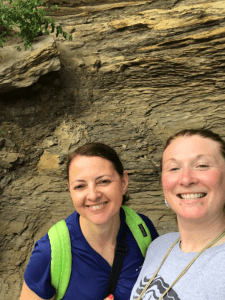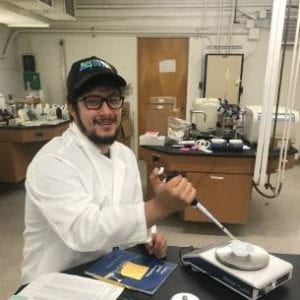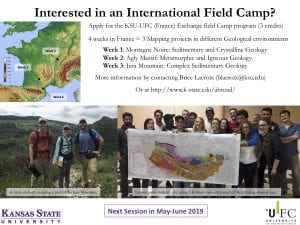The department of Geology is pleased to introduce our new postdoctoral researcher. Continue reading “Introducing New People”
Prof Saugata Datta moves to University of Texas at San Antonio
 Prof Saugata Datta, faculty member in Department of Geology for the past 11 years, has left K-State to take up the Weldon Hammond Chair in Hydrogeology at the University of Texas, San Antonio. Dr. Datta is well known for his outstanding reputation in research, having a long record of publicaton in high impact journals and winning research grants worth nearly $1.5 million over the past 10 years. His work on water quality issues around the world has significant societal relevance and impact. His students will miss his infectious enthusiasm, breadth of knowledge, seemingly boundless energy, and unwavering support. We wish him well in his new role.
Prof Saugata Datta, faculty member in Department of Geology for the past 11 years, has left K-State to take up the Weldon Hammond Chair in Hydrogeology at the University of Texas, San Antonio. Dr. Datta is well known for his outstanding reputation in research, having a long record of publicaton in high impact journals and winning research grants worth nearly $1.5 million over the past 10 years. His work on water quality issues around the world has significant societal relevance and impact. His students will miss his infectious enthusiasm, breadth of knowledge, seemingly boundless energy, and unwavering support. We wish him well in his new role.
Spotlight on undergraduate research
Undergraduate student Lindsay Gutierrez is currently working with Dr. Goldberg on a senior thesis entitled Paleocurrent and provenance analysis of an incised-valley fill at Echo Cliff, KS. Echo Cliff, located southwest of Dover, KS, is a 75-foot exposure of channel-fill deposits accumulated in incised valleys that cut down into the Pennsylvanian marine succession during a sea-level fall. Much of the material filling the channel is believed to have come from the uplands to the  north and northwest, but to date no systematic study of the provenance of these sediments was carried out. The purpose of Lindsay’s study is to reconstruct the sediment pathways and to identify potential source areas. During summer 2019, she carried out a detailed facies analysis, with construction of a sedimentary log that included facies attributes and systematic measurement of paleocurrents, and also collected sandstone samples for further petrographic analysis. Lindsay has identified 7 lithofacies deposited in a meandering fluvial environment and a provenance analysis. The integration between paleocurrent and compositional analyses in the sediments exposed at Echo Cliff, with the analysis of regional geological maps, pointed to potential source areas upstream for fluvial deposits. Lindsay’s research identified that the sediments that filled the incised valleys at Echo Cliff probably came from low-grade metamorphic terrains in Washington or Oregon, travelling southeast through Idaho, Wyoming/Montana, Colorado/Nebraska, and finally Kansas. The long distance of transport (about 2,000 miles) is compatible with the fine grain size, good sorting and quartzose composition of the sediments. Lindsay presented her results in a poster at the GSA conference in Phoenix, AZ.
north and northwest, but to date no systematic study of the provenance of these sediments was carried out. The purpose of Lindsay’s study is to reconstruct the sediment pathways and to identify potential source areas. During summer 2019, she carried out a detailed facies analysis, with construction of a sedimentary log that included facies attributes and systematic measurement of paleocurrents, and also collected sandstone samples for further petrographic analysis. Lindsay has identified 7 lithofacies deposited in a meandering fluvial environment and a provenance analysis. The integration between paleocurrent and compositional analyses in the sediments exposed at Echo Cliff, with the analysis of regional geological maps, pointed to potential source areas upstream for fluvial deposits. Lindsay’s research identified that the sediments that filled the incised valleys at Echo Cliff probably came from low-grade metamorphic terrains in Washington or Oregon, travelling southeast through Idaho, Wyoming/Montana, Colorado/Nebraska, and finally Kansas. The long distance of transport (about 2,000 miles) is compatible with the fine grain size, good sorting and quartzose composition of the sediments. Lindsay presented her results in a poster at the GSA conference in Phoenix, AZ.
Geology Outreach and Agriculture
Gonzalo Alcantar was one of three students in the KS-LSAMP program sponsored  by the Kansas NSF EPSCOR RII Track-1 Award OIA-1656006: Microbiomes of Aquatic, Plant and Soil Systems across Kansas (MAPS). His mentor, Dr. Matt Kirk is an Associate Professor of Geology at Kansas State University (KSU) and MAPS Soils Team leader. The title of Gonzalo’s research project is Variation in contribution of groundwater discharge to streams across the Kansas precipitation gradient. He said that he picked this particular topic because “I am interested in everything that goes into agriculture/farming and aquaponics/vertical farming, hence the water research.”
by the Kansas NSF EPSCOR RII Track-1 Award OIA-1656006: Microbiomes of Aquatic, Plant and Soil Systems across Kansas (MAPS). His mentor, Dr. Matt Kirk is an Associate Professor of Geology at Kansas State University (KSU) and MAPS Soils Team leader. The title of Gonzalo’s research project is Variation in contribution of groundwater discharge to streams across the Kansas precipitation gradient. He said that he picked this particular topic because “I am interested in everything that goes into agriculture/farming and aquaponics/vertical farming, hence the water research.”
Featuring Faculty Research: When gold meets landslides
With about 75% of the gold produced coming from “orogenic gold systems” (i.e. gold formed during orogenic processes and deformation), it’s not surprising we want to understand how these deposits form. One important part of Brice Lacroix’s research consists of defining the geometry of Au-deposits, and to link the mineralization to the different tectonic events that the area experienced in the past. Such an approach generally uses field investigation through structural and geological mapping coupled with cutting-edge petrography (e.g. fluid inclusion microthermometry, and geochemistry techniques). Continue reading “Featuring Faculty Research: When gold meets landslides”
Departure of Sam Chaudhuri
Dr. Sambhudas Chaudhuri retired in December 2017, after 52 years of service to the Department of Geology and Kansas State University. Read on to find out how you can help to establish a scholarship in his honor. Continue reading “Departure of Sam Chaudhuri”
Updating the Department History
The Geology Alumni Advisory Council celebrated its 40th anniversary this year. In celebration of that event, Pamela Kempton updated the history of geology at K-State, written originally by Dr. Joseph Chelikowsky. Click here to download a copy of the updated history.
International Connections Lead to New field camp for K-state undergraduate students
Spotlight on undergraduate research
Undergraduate student Hallie Bruce first became interested in Petrology during the spring 2018 semester while taking GEOL 503, taught by Dr. Kempton. In class, she learned more about magmatic and metamorphic processes through careful petrographic investigation and long hours observing thin sections through a petrographic microscope. It was then that she started to become more interested in economic geology and using petrology to understand the formation of ore-deposits, and during summer 2018, she decided to do a research project with Dr. Lacroix on the topic. As a result of her summer research experience, she has decided to work toward a senior thesis that will focus on one aspect of ore deposit petrology: fluid inclusions. Continue reading “Spotlight on undergraduate research”
